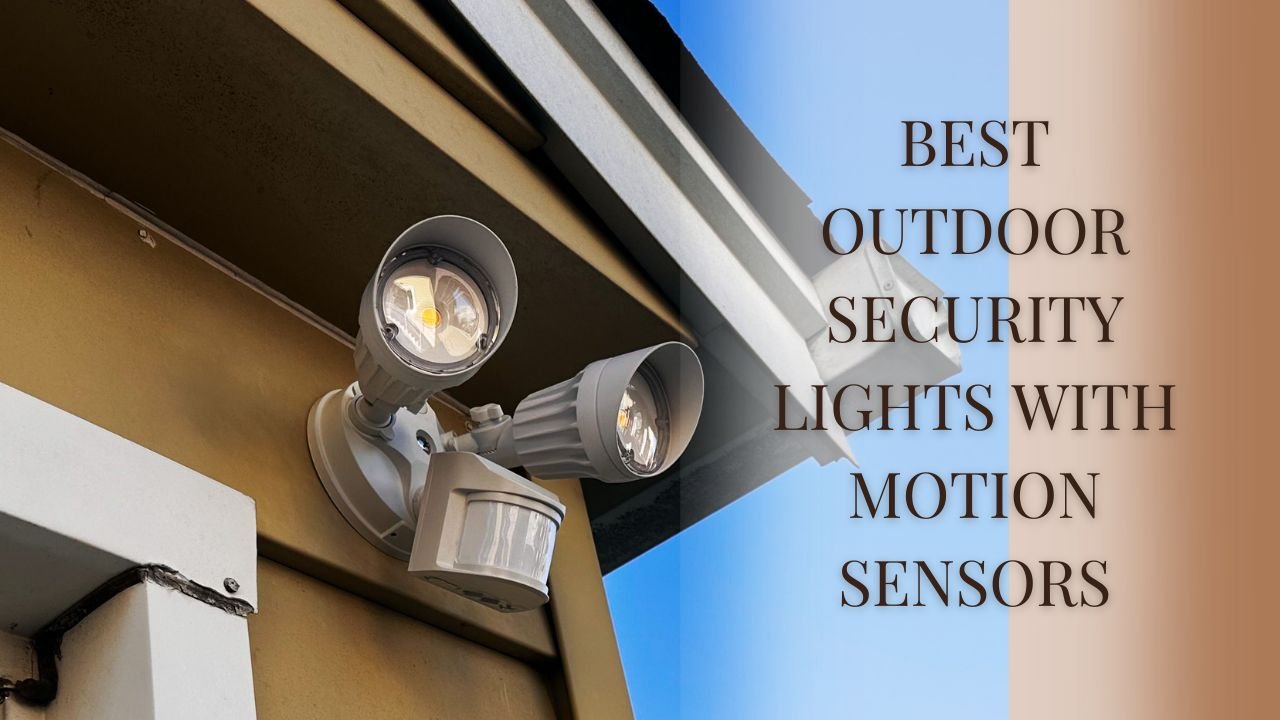In a world where home security is more important than ever, choosing the best outdoor security lights with motion sensors can make all the difference.
These intelligent lighting systems not only act as powerful deterrents against intruders but also enhance nighttime visibility, helping prevent accidents and ensuring safer movement around your property.
Modern motion sensor lights come equipped with energy-efficient LEDs, adjustable sensitivity settings, and even smart integration with home security apps.
Whether you’re securing your driveway, backyard, or main entrance, the right motion light provides instant illumination the moment movement is detected — offering both protection and peace of mind, all while saving on electricity costs.
Why Motion Sensor Security Lights Are Essential
Outdoor lights that activate on motion are more than convenience — they’re a smart security solution. Some of their advantages:
- Deterrence: Sudden light discourages intruders from approaching.
- Energy efficiency: They remain off until motion triggers them.
- Improved visibility: Illuminate paths, driveways, and entryways.
- Integration with smart systems: Many can tie into security systems or apps.
Because they respond only when triggered, motion sensor lights reduce light pollution and keep your energy costs low.
Key Specifications to Compare
Before choosing a model, understand these crucial metrics:
| Specification | Best Range / Value | Why It Matters |
|---|---|---|
| Brightness (Lumens) | 800 – 3,500+ lm | Determines how far and how bright the light covers |
| Detection Range / Angle | 30–60 ft, 120°–180° | Wider angle and longer reach cover more area |
| Power Source | Hardwired / Solar / Battery | Hardwired is stable; solar is easy to install |
| Weather Rating (IP) | IP65, IP66 or higher | Ensures durability in rain, dust, and elements |
| Adjustability | Tilt, sensitivity, timeout | Lets you fine-tune light behavior to your setup |
Agents, testers, and homes stress that versatile adjustment — customizing brightness, angle, and delay time — is often what separates mediocre lights from top performers.
Top Motion Sensor Security Lights to Consider
Below are standout models currently available that exemplify different categories — from solar to floodlight to all-in-one. Each has features that may match your needs.
Here are a few to highlight:
- Solar Wireless Motion Sensor Lights: Compact and affordable. Ideal for gardens and small yards.
- Seafront All‑in‑One Solar Street Light: Designed like a streetlamp with integrated battery, panel, and sensor — perfect for pole mounting.
- Halonix Solaris Waterproof LED Flood Light: A durable floodlight option suited for driveways or large open areas.
- 2‑Pack LED Solar Motion Lights: Comes in a pair, giving you flexibility to light multiple zones.
- Gesto Solar Wall Light: Sleek wall-mounted design, good for porches and entrance lighting.
Each of these offers motion detection, weather resistance, and efficient power usage — though their brightness, angle, and installation style vary.
How to Choose the Right Light for Your Setup
1. Assess Your Coverage Needs
- Entryway or porch: A narrow-angle, lower-lumen model may suffice.
- Driveway or yard: Opt for higher lumen and wider detection to cover the space.
2. Select the Power Type
- Hardwired: Reliable, consistent, less maintenance.
- Solar: Easier install, cheaper operation — but performance depends on sunlight exposure.
- Battery or hybrid models: Good balance in shaded areas or for backup use.
3. Set Sensitivity and Timing
Too sensitive? You’ll get false triggers from pets or wind. Too weak? motion may not register from desired range.
Choose models where you can set delay times (how long light stays on) and angle settings.
4. Consider Smart Integration
If you have home automation, look for Wi-Fi or smart home compatibility. Some lights can link to cameras, alarms, or your phone alerts.
5. Protect from the Elements
Look for IP65 or higher ratings to withstand rain and dust. Make sure no openings or cracks over time that degrade performance.
Installation Guidelines & Best Practices
- Mount 6 to 10 feet high, angled downward ~15°–25° to avoid horizon glare.
- Avoid direct line with vehicle headlights or motion on the street to reduce false triggers.
- Use overlapping coverage zones — two lights overlapping ensures no blind spots.
- Test at night immediately after installation and adjust to reduce false triggers.
- Clean the lens quarterly; dirt or insect webs reduce sensitivity.
Model Comparison at a Glance
| Model | Lumens / Brightness | Detection Range / Angle | Power Type | Best For |
|---|---|---|---|---|
| Solar Wireless Motion Sensor Lights | ~1,000 lm | ~20–30 ft / 120° | Solar + battery | Small yard, pathways |
| Seafront All-in-One Solar Street Light | ~1,500 lm | 40 ft / 180° | Solar integrated | Street or pole mounting |
| Halonix Solaris Flood Light | ~2,000–3,000 lm | 50 ft / wide flood angle | Hardwired or solar | Driveways, wide open areas |
| 2-Pack LED Solar Motion Lights | ~1,200 lm each | ~25 ft / 120° | Solar | Dual-zone usage |
| Gesto Solar Wall Light | ~800–1,000 lm | ~15–20 ft / 100° | Solar | Porches, entryways |
This table helps you see how far light will reach and which setup suits your zones best.
Practical Tips & Common Pitfalls
- Don’t leave lights on constantly — many security experts caution that always-on lights may cast deep shadows and reduce visibility in some zones. Motion-activated is often safer.
- Avoid mounting near heaters, air vents, or trees, which may cause false triggers due to heat or movement.
- Keep solar panels clean and oriented for maximum charge — shade can sharply reduce performance.
- In multi-unit settings, coordinate light schedules to avoid conflicts or overlapping triggers.
Choosing the best outdoor security lights with motion sensors in 2025 involves more than just picking the brightest model. You must consider detection range, power source, weather protection, and adjustability.
Whether you need a sleek wall-mounted solar light for your doorstep or a powerful floodlight to guard your driveway, the right setup will boost both safety and peace of mind.
Barricade your dark zones, eliminate blind spots, and select a light that fits your environment — and with proper installation and configuration, your home will be illuminated when it counts, deterring intruders and guiding your path safely at night.
FAQs
What brightness (lumens) do I need for security lighting?
Aim for at least 1,000 lumens for porch or pathway, and 2,000–3,000+ lumens for driveways or large yards.
Will solar lights work in cloudy or shaded regions?
They may underperform. Choose panels with high efficiency and consider hybrid or battery-assisted models. Ensure panels get some direct sunlight during the day.
Can motion sensor lights integrate with home security systems?
Yes. Many models now connect via Wi-Fi, Zigbee, or smart home platforms to trigger cameras, notifications, or alarms when motion is detected.




